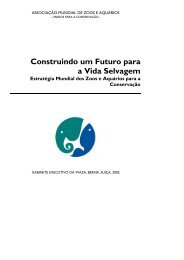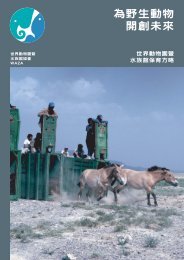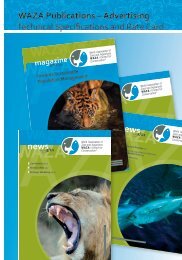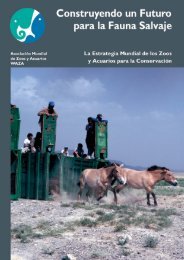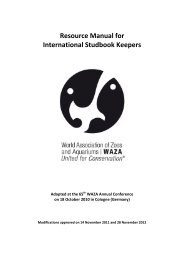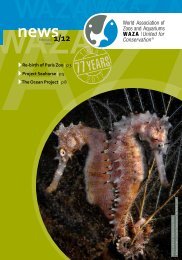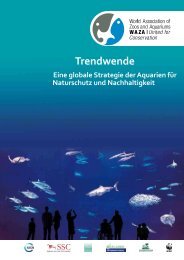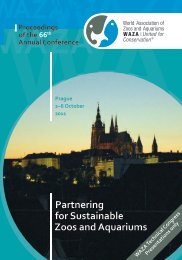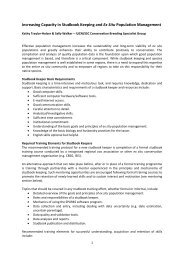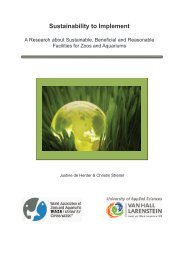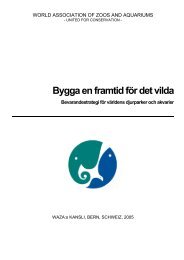Towards Sustainable Population Management - Waza
Towards Sustainable Population Management - Waza
Towards Sustainable Population Management - Waza
Create successful ePaper yourself
Turn your PDF publications into a flip-book with our unique Google optimized e-Paper software.
WAZA magazine Vol 12/2011<br />
Markus Gusset<br />
Editorial<br />
1 & Gerald Dick2 A recent evaluation of the status of<br />
the world’s vertebrates (Hoffmann<br />
et al. 2010; Science 330: 1503–1509)<br />
showed that one-fifth of species are<br />
classified as threatened. On average,<br />
52 species of mammals, birds and<br />
amphibians move closer to extinction<br />
each year. However, the rate of deterioration<br />
would have been at least<br />
one-fifth more in the absence of conservation<br />
measures. Therefore, while<br />
current conservation efforts remain<br />
insufficient to offset the main drivers<br />
of biodiversity loss, this overall pattern<br />
conceals the impact of conservation<br />
successes. Notably, conservation<br />
breeding in zoos and aquariums has<br />
played a role in the recovery of 28%<br />
of the 68 species whose threat status<br />
was reduced.<br />
To fulfil the full suite of conservation<br />
roles required of animal populations<br />
in human care, they must be<br />
demographically robust, genetically<br />
representative of wild counterparts<br />
and able to sustain these characteristics<br />
for the foreseeable future. In<br />
light of growing concerns about the<br />
long-term sustainability of captive<br />
populations, WAZA organised<br />
a two-day workshop in April 2011 on<br />
the sustainable management of zoo<br />
animal populations. This workshop,<br />
which was an integral part of a series<br />
of workshops on related topics<br />
summarised in this edition of the<br />
WAZA Magazine, tackled the issue<br />
of studbook-based global population<br />
management, which lies at the heart<br />
of successful conservation breeding<br />
programmes aimed at preserving<br />
biodiversity.<br />
1 WAZA Conservation Officer &<br />
International Studbook<br />
Coordinator<br />
2 WAZA Executive Director<br />
© Nicole Gusset-Burgener<br />
Lion (Panthera leo) in the Serengeti.<br />
In this edition of the WAZA Magazine,<br />
the results of population sustainability<br />
assessments globally (Lees &<br />
Wilcken) and in three major regions<br />
(Australasia: Hibbard et al.; Europe:<br />
Leus et al.; North America: Long et<br />
al.) are presented. Two important biological<br />
factors impacting population<br />
sustainability are reviewed, namely<br />
genetics (Ballou & Traylor-Holzer) and<br />
mate choice (Asa et al.). Overviews<br />
of how biodiversity is represented in<br />
zoological institutions (Conde et al.),<br />
managed programmes (Traylor-Holzer)<br />
and studbooks (Oberwemmer et<br />
al.) are provided, including a study on<br />
studbook-driven husbandry success<br />
(Müller et al.). Finally, a vision for the<br />
future of population sustainability is<br />
outlined (Baker et al.).<br />
We hope that this edition of the<br />
WAZA Magazine will make a substantial<br />
contribution to the challenge of<br />
how animal populations in human<br />
care can be managed sustainably in<br />
the long term, and thereby further<br />
increase the contribution of the world<br />
zoo and aquarium community to<br />
global biodiversity conservation.<br />
1



